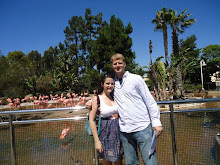
The Three Little Dassies is the much beloved Three Little Pigs with an African spin. Three sisters, Mimbi, Pimbi, and Timbi move away from home, with the very untypical warning to watch out for the eagle. The sisters each build their own houses from different materials, grass, driftwood, and stone in the Namib Desert of Southern Africa. The eagle gives his warning of "I'll flap and I'll clap and I'll blow your house in." Then, with the help of their new neighbor, the sisters (and maybe even the readers) learn a very valuable lesson about hard work.
The art is done in watercolors and gouache. The airbrush backgrounds were created by Joseph Hearne. One large picture graces the center of the page and two side panels float in the margins. Each drawing is framed or bordered with culturally bright prints and fabrics. These side panels provide additional visual images and let observant picture book readers know more about what is or will be happening in the main frame of the story.
Booklist's Andrew Wedlar gives high praise to Brett's drawings. He states "Brett invokes the African setting with details of the desert landscape and the animals' colorful patterned clothing. The last page turns the story into an inspired pourqoui tale about dassies' habitat and soot like coloring of native eagles. School Library Journal's Carrie Rogers-Whitehead states that "Children will enjoy following both stories and will linger on each page following the exciting detail of the setting; the desert, the characters, the decorative boarders and all the small touches in between. This tale will captivate children and introduce a setting and unfamiliar animals to most of them." Though no awards were noted, this book has appeared on the New York Times bestseller list, as well Publisher's Weekly's list.
The dassies, by their more technical name of rock hyraxes, resemble a cross between a prairie dog and a Kola bear. Their cute little paws and charming noses make them wonderful damsels in distress for the Agama Man, a colorful lizard, to save from the eagles nest.
In the tale, the dassies are wearing colorful versions of traditional African dress. As a matter of fact, as is characteristic of many traditional tales, animals are often given human characteristics or repurposed. For example, a turtle assumes the role of a pack mule as the dassies move away from home.
This variant was written by Jan Brett and the fact that she is not African is the only strong criticism that I can muster. She says in the jacket that she was inspired to write the story of the three little dassies after seeing them on vacation. I realize this is a children's tale. However, the fact that she wrote this after a vacation makes me question some of the attempts at authenticity. Prints and certain colors are often of tribal and regional significance throughout Africa. I feel that this significance would be difficult to detect as a vacationer.
On the other hand, this variant offers teachers and students the opportunity to study nature and wildlife in the desert. After studying the different types of predators and prey that exist in the desert or other ecosystems, perhaps students could write their own variant of the three little pigs. This would give students the opportunity to research different ecosystems and to be creative when they work at adapting the tale. For example, they would have to decide what kind of resources would be available to the animals with which to build their houses. Students could also discuss the evolutionary purposes for a black eagle that appears in the pourqoui ending of this variant.
Before reading this tale, I would ask students what they think it would be like to live in the desert or to move away from home on their own. After reading this tale, I would ask students about which dassie they think is the most intelligent and why she was rewarded.
Other unique cultural variations of The Three Little Pigs include The Three Tamales by Eric Kimmel and Valeria Docampo and The Little Cajun Pigs by Mike Artell and Jim Harris.
I find so much value in this text. The text reads evenly and could be mastered by a young independent reader. That reader would most likely know the plot and could focus on the words. He or she would still have the rewards of mastering a book that might be considered difficult. Young readers can learn so much about different animals, cultures and ecosystems and the importance of hard work.
Reference:
Brett, Jan. The Three Little Dassies. New York: G. P. Putnam's Sons, Penguin Young Reader's Group, 2010. ISBN: 978-0-399-25499-4.
Reference




No comments:
Post a Comment